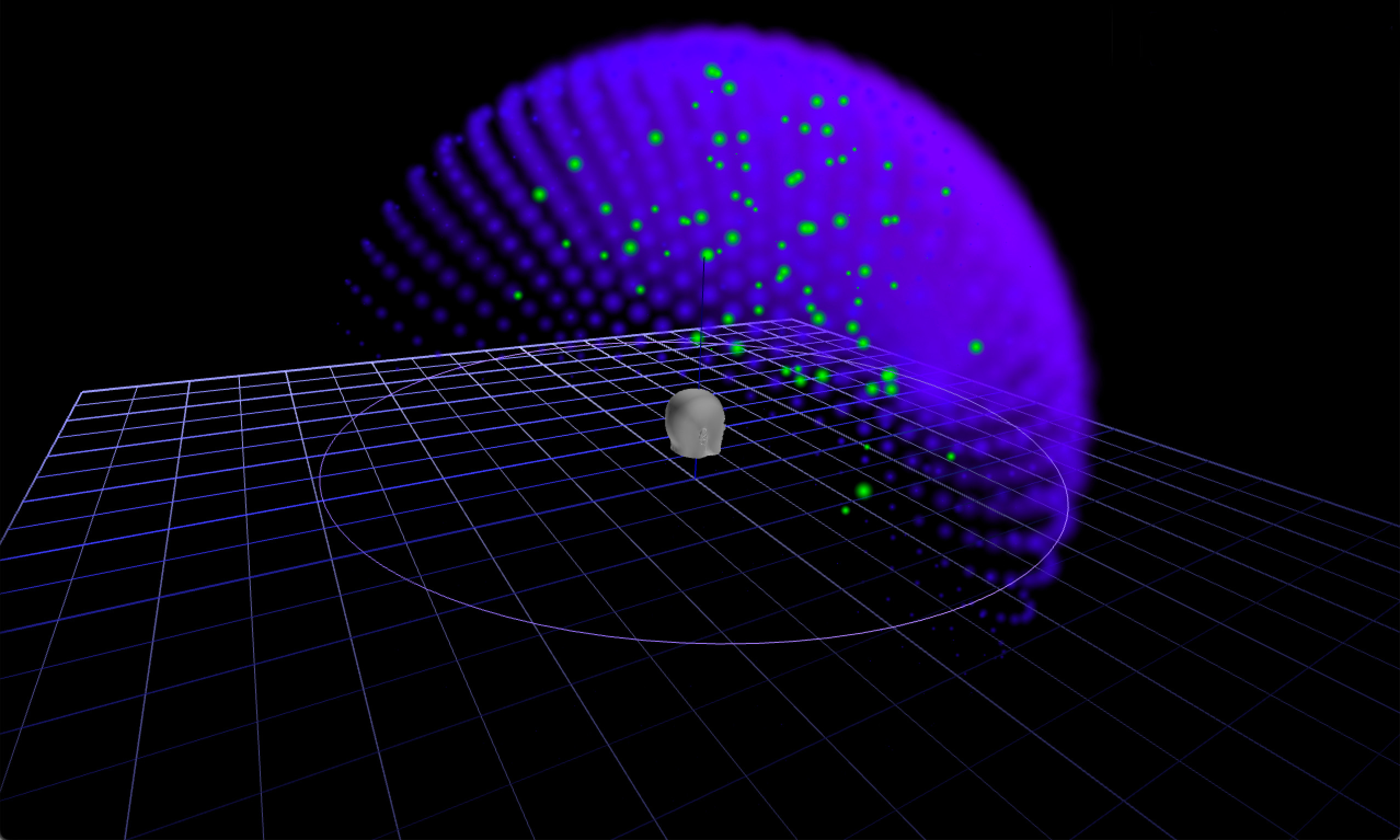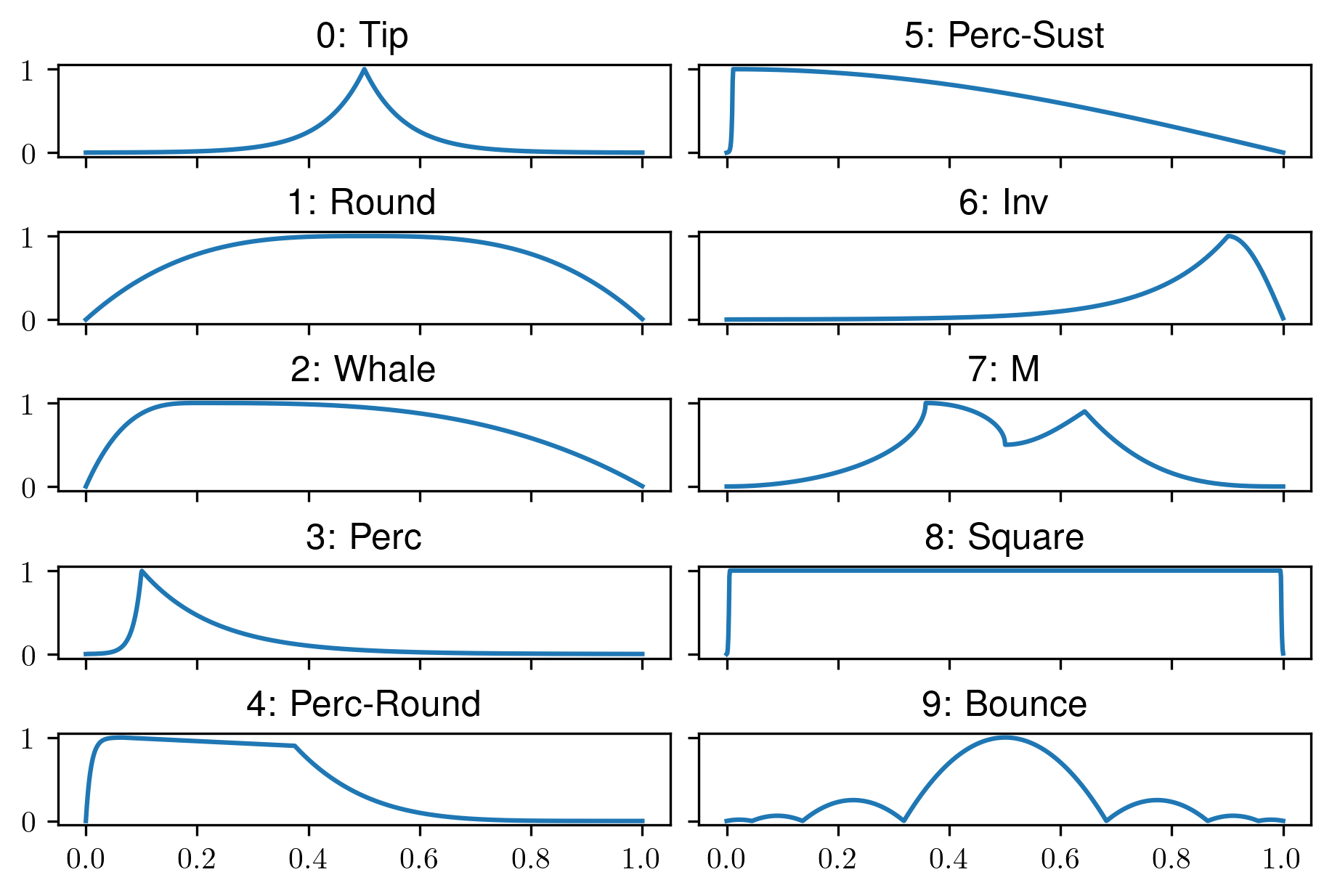Granulator
This tool is a spatial granular synthesizer1. It generates $N$ streams of “grains” from sound files or from the input signal and spatialize each grain in a moving swarm. The latter is encoded to an Ambisonics bus up to degree $L$. A visual example, of a swarm, made with AntesCollider1, is shown in the following Fig.:

Compilation parameters
L: maximal Spherical Harmonics degree (i.e., Ambisonics order), $L > 0$,N: number of grain streams to synthesize.
Warning: the compilation can last several hours as $L$ and $N$ increase1. Don’t forget the flag -t 0 with the faust2... scripts, as well as the -soundfile tag to embbeded your sound files. It is better practice to compile for low N value and launch several instances of the plugin in your host.
S: number of sound file to load: The corresponding sound files path should be given in thesoundvariable with the following syntax:sound = soundfile("File[url:{'../path/to/soundfile1.wav';'../path/to/soundfile2.wav'}]", 1);,bufsize: length of the buffer (in seconds) for the input signal,oscmeter: generates $N \times 4$ bargraphs in the GUI in order to transmit through OSC each grain spherical coordinates and its instantaneous level.0=> No bargraphs,1=> bargraphs. This parameter is useful to drive an external visualizer.
Warning : oscmeter=1 parameter can produce huge GUI if you set a high number $N$ of grains.
markerq: use a marker list for each sound file ?0=> No, i.e., each grain starting sample is chosen randomly withing the sound file start and stop index (see User Interface).1=> Yes, i.e. each grain starting sample is chosen randomly from the marker list. The marker lists are given as sample number in the parametersmarker(i)with $i \in [0 \cdots S-1]$ see hereafter:marker(i): The $i$-th soundfile marker list with $i \in [0 \cdots S-1]$. Each list is given as a list of sample number in the corresponding sound file with the following syntax for $i=0$ :marker(0) = waveform{10240, 59904, 1821184, ..., 3272192.0};.
Inputs / Outputs
- Inputs: $1$ (for “live” granulation)
- Outputs: $(L+1)^2$
User Interface
The user interface is divided into two sections: To generate a swarm of $N$ stream of grains, one proceeds as follows:
1) The sound source is chosen between soundfiles or input using the checkbox Soundfile/Input :
- If the
soundfilesource is chosen (Soundfile/Input=0), then the soundfile is chosen among the $S$ sound files defined at compilation time (see Compilation parameters) using the sliderSoundfile. - If the
inputsource is chosen (Soundfile/Input=1), then the input signal buffer is chosen as a sound source. To fill/update this buffer with the current input signal, one setRecord=1.
In the latter case, when the buffer is full, older values are replaced with new ones while Record=1 (i.e. circular buffer behaviour).
2) Several ranges are set for each grain parameters in the $N$ streams using corresponding min and max sliders. Each grain has a set of parameters as follows:
Length: the grain duration (in seconds),Shift: the grain starting index within the sound source. The value is normalized between $0$ and $1$, where $1$ represents the lenght of the sound source (soundfileorinput).
Note that this parameter has no influence if the soundfile source is chosen and markers are used (see Compilation parameters)
Read Speed: the grain playback speed. This can produce pitching effectReverse Forward: the grain playback direction between $-1$ and $1$. If the value is negative the grain is played back in reverse direction. If the value is positive, the grain in played in the forward direction.Radius: the radius position of the grain in the swarm,Azimuth: the azimuth position of the grain in the swarm,Elevation: the elevation parameter of the grain in swarm.
Note that each grain parameter is chosen randomly within the corresponding range. Then, the grain is played and a new set of parameters is chosen randomly. Therefore, $N$ grains stream are synthesized within with constantly varying parameters within the ranges. The ranges for Radius Azimuth and Elevation define a spherical sector (including radius) where each grain is spatialized, hence forming a swarm.
3) Two envelops are chosen (Env 0 and Env 1 parameters) and a crossfade (Envs Crossfade parameter) between these two envelops is applied on each grain in the $N$ streams.
The current envelops with their name and corresponding number are shown in the following Figure:

4) Meta parameters applied on the $N$ grain streams are chosen:
Gain: the global gain (in dB),Probability: probability, between $0$ and $1$, of a grain to be played.
Finally, the user interface parameters are as follows:
| Element | OSC | Min value | Max value |
|---|---|---|---|
Radius Min (float, m) |
radius_min |
0.5 | 50 |
Radius Max (float, m) |
radius_max |
0.5 | 50 |
Azimuth Min (float, $^\circ$) |
azimuth_min |
-180 | 180 |
Azimuth Max (float, $^\circ$) |
azimuth_max |
-180 | 180 |
Elevation Min (float, $^\circ$) |
elevation_min |
-90 | 90 |
Elevation Max (float, $^\circ$) |
elevation_max |
-90 | 90 |
Env 0 (int) |
env0 |
0 | 9 |
Env 1 (int) |
env1 |
0 | 9 |
Envs Crossfade (float) |
envs_crossfade |
0 | 1 |
Probability (float) |
proba |
0 | 1 |
Input/Soundfile (int) |
input_soundfile |
0 | 1 |
Record (int) |
record |
0 | 1 |
Soundfile (int) |
soundfile |
0 | S |
Gain (float, dB) |
gain |
-40 | 0 |
Length Min (float, s) |
length_min |
0 | 20 |
Length Max (float, s) |
length_max |
0 | 20 |
Read Speed Min (float) |
read_speed_min |
-1 | 1 |
Read Speed Max (float) |
read_speed_max |
1 | 1 |
Shift Min (float) |
shift_min |
0 | 1 |
Shift Max (float) |
shift_max |
0 | 1 |